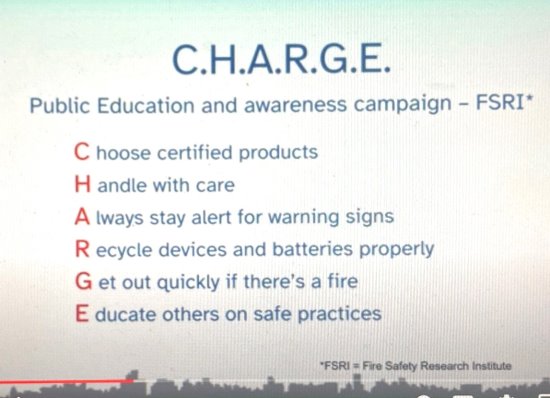
| ||||||
Those insights about EVs, e-bikes, hoverboards, and e-scooters were voiced at the latest gathering of Lamorinda CERT in an online Zoom meeting held on March 11 with guest Capt. Dan Dick, from the Moraga Orinda Fire District, who also is a CERT instructor for utilities, hazard materials, and fire safety module.
"This is (a) $40-billion-dollar industry that is only growing, and we gotta start understanding how these things can us hurt and how we can protect ourselves," he said.
Dick cited a central question related to e-batteries - how are we going to get that induction motor in the vehicle the power it needs to function?
As part of the presentation, a brief e-battery tutorial was given to explain their chemistry in order to spotlight what is transpiring as batteries are charged and the impact of temperature variants.
"Batteries are like Goldilocks - they don't like too hot or too cold. They like it just right' and when it gets out of those parameters on the hot side that is when bad things can happen," Dick said.
When considering the greater amount of charge that battery has, "that can create the problem for us as first responders and you as the user of these devices," Dick continued.
Three specific problems areas - mechanical, thermal, and electrical abuse - were noted with the e-batteries.
Mechanical involves physically damaging the unit, such as during a vehicle accident, which in turn interferes with normal operation. Thermal is heat-related, and when heat builds due to the lack of air conditioning or airflow reaching the cells, this can lead to problems like off-gassing. Electrical abuse happens while overcharging, undercharging, or shorts from the inverter. Often, damage can be reversed if caught quickly.
As part of the Zoom presentation, videos were shown to illustrate the potential problems.
In one video, a controlled experiment with an e-scooter showed what can result when electrical abuse occurs with batteries. This film further illustrated the lack of time there is to react and survive in such cases.
A second video shown was an incident from 2018, demonstrating how quickly things happen when off gassing occurs in an uncontrolled environment. An adult went to investigate after a family pet noticed something was amiss; soon after, the camera in the room captured the growing plume of smoke and the fire that ensued, all within 15 seconds.
"That is why I have tried to start educating myself about the dangers of these batteries and mobility devices," said Dick. "When things happen to these batteries, bad things happen."
During the follow up Q&A session with attendees of the presentation, queries were made, including one seeking advice for charging e-vehicles.
"Anything that uses a battery to power the induction motor to make that car go is prone to accidents," said Dick of the universal concerns surrounding e-vehicles, whether they are a Tesla model, Nissan Leaf, Chevy Volt, or whatever the car maker.
He noted different car makers are using bigger cells that generate more heat compared to Tesla.
"Different car manufacturers have different ways to deal with potential problems," Dick continued.
For where one should recharge a vehicle, "I would charge outside," he said.
Regarding the range for keeping the battery charged, it is recommended for every day driving to keep it between 50 to 80% for longer state of charge (SOC), which also means fewer charging cycles are needed. Frequent overcharging heats up the battery. As for running it down, it should not go below 20%, at which point one should start thinking about charging again.
"If you smell something and you are driving and hear some crackling or popping, or see off gassing, don't drive into your garage," said Dick. "Leave (the vehicle) outside. That is (a) sign of imminent problems."
E-battery disposal options
A few local options accept the batteries used for different e-mobility devices, excluding e-batteries for powering electric cars.
REI - Concord, in the Willow Shopping Center, 1975 Diamond Blvd., accepts batteries for e-bikes, as well as those for skateboards, scooters, and hoverboards.
Those merchants accepting only electric batteries used to power bicycles include: two in Walnut Creek, Encina Bicycle Center, 2901 Ygnacio Valley Rd., and Mike's Bikes - Walnut Creek, 1615 North California Blvd.; First Mile Cycle Works, 3566 Mt. Diablo Blvd, in Lafayette.; and at two Alamo locations, The Trek, 80 C Alamo Plaza, and California Bike and Snowboard, 1483 Danville Blvd.
Another option for proper disposal is Hayward-based Clean Earth. It accepts various smaller wattage batteries that power mobility devices for a fee on the second Friday of each month at 30677 Huntwood Ave., off Industrial Parkway. Visit the company's website www.cleanearthinc.com for more details and price information.
Call these specific businesses for more information and to confirm they are currently accepting e-batteries, or contact the manufacturer of the battery for proper disposal options.
Reach the reporter at:
